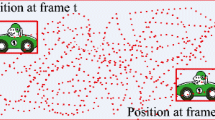Abstract
This paper presents a novel human body part tracker called sequential Markov random fields (SMRFs), which can be used to extract spatiotemporal features in human action recognition. Given a video sequence of human action in the monocular settings, SMRF can effectively detect the key spatiotemporal feature points on human body parts. We also develop efficient learning algorithms for the SMRF tracker using relaxation labeling (RL). Our results show that the SMRF tracker performs better than some state-of-the-art trackers for human action recognition.









Similar content being viewed by others
Notes
We denote \(p\left(y_i^t,y_{i^{\prime}}^t\big|f_i^t=L_j^t,f_{i^{\prime}}^t=L_{j'}^t\right)\) as \(p\left (y_i^t,y_{i^{\prime }}^t\big |L_j^t,L_{j^{\prime }}^t\right )\)when we consider the structure of a pose.
We denote \(p\left (y_i^t|f_i^t=\hat {x}_j^t\right )p\left (y_i^t, y_i^{t-1}| f_i^t=x_j^t,f_i^{t-1}=x_j^{t-1}\right )\)as \(p\left (y_i^t|\hat {x}_j^t\right )p\left (y_i^t, y_i^{t-1}| x_j^t,x_j^{t-1}\right )\)when we consider the dynamic motion.
References
Arulampalam MS, Maskell S, Gordon N, Clapp T (2002) A tutorial on particle filters for online nonlinear/non-gaussian bayesian tracking. IEEE Trans Sig Process 50(2):174–188
Biederman I (1987) Recognition-by-components: a theory of human image understanding. Psychol Rev 94(2):115–147
Blank M, Gorelick L, Shechtman E, Irani M, Basri R (2005) Actions as space-time shapes. In: ICCV, pp 1395–1402
Dollár P, Rabaud V, Cottrell G, Belongie S (2005) Behavior recognition via sparse spatiotemporal features. Vis Surveill Perform Eval Tracking Surveill 2:65–72
Gu B, Hong L (2001) Tracking 2d rigid targets with invariant constraints. Inf Sci 138:79–97
Hammersley JM, Clifford P Markov fields on finite graphs and lattices. unpublished
Hue C, Cadre J-PL, Perez P (2002) Sequential monte carlo methods for multiple target tracking and data fusion. IEEE Trans Sig Process 50(2):309–325
Isard M, Blake A (1998) Condensation-conditional density propagation for visual tracking. Int J Comput Vis 29(1):5–28
Johansson G (1973) Visual perception of biological motion and a model for its analysis. Percept Psychophys 14:201–211
Kato J, Watanabe T, Joga S, Liu Y, Hase H (2004) An HMM/MRF-based stochastic framework for robust vehicle tracking. IEEE Trans Intell Transp Syst 5(3):142–154
Khan Z, Balch T, Dellaert F (2005) Mcmc-based particle filtering for tracking a variable number of interacting targets. IEEE Trans Pattern Anal Mach Intell 27(11):1805–1819
Laptev I, Marszałek M, Schmid C, Rozenfeld B (2008) Learning realistic human actions from movies. In: CVPR
Le QV, Zou WY, Yeung SY, Ng AY (2011) Learning hierarchical spatiotemporal features for action recognition with independent subspace analysis. In: CVPR, pp 3361–3368
Lee MW, Nevatia R (2009) Human pose tracking in monocular sequence using multilevel structured models. IEEE Trans Pattern Anal Mach Intell 31(1):27–38
Li SZ (2001) Markov random field modeling in image analysis. Springer, Tokyo
Magnenat-Thalmann N, Thalmann D (1991) Complex models for animating synthetic actors. IEEE Comput Graph Appl 11(5):32–44
Marszalek M, Laptev I, Schmid C (2009) Actions in context. In: CVPR
Okuma K, Taleghani A, de Freitas N (2004) A boosted particle filter: multitarget detection and tracking. In: European Conference on Computer Vision (ECCV), pp 28–39
Rodriguez MD, Ahmed J, Shah M (2008) Action MACH a spatiotemporal maximum average correlation height filter for action recognition. In: CVPR
Schuldt C, Laptev I, Caputo B (2004) Recognizing human actions: a local SVM approach. In: ICPR, vol 3, pp 32–36
Song Y, Goncalves L, Perona P (2003) Unsupervised learning of human motion. IEEE Trans Pattern Anal Mach Intell 25(7):1–14
Tomasi C, Kanade T (1991) Detection and tracking of point featues. Technical Report CMU-CS-91-132, Carnegie Mellon Univ.
Wang H, Ullah MM, Klaser A, Laptev I, Schmid C (2009) Evaluation of local spatiotemporal features for action recognition. In: BMVC, pp 3361–3368
Wang Y, Mori G (2009) Human action recognition by semilatent topic models. IEEE Trans Pattern Anal Mach Intell 31(10):1762–1774
Wu Y, Hua G, Yu T (2003) Tracking articulated body by dynamic markov network. In: IEEE Internatioal conference on computer vision (ICCV), pp 1094–1101
Wu Y., Yu T (2006) A field model for human detection and tracking. IEEE Trans Pattern Anal Mach Intell 28(5):753–765
Yang C, Duraiswami R, Davis L (2005) Fast multiple object tracking via a hierarchical particle filter. In: IEEE Internatioal conference on computer Vision (ICCV), pp 212–219
Yu Q, Medioni G (2009) Multiple target tracking by spatio-temporal Monte Carlo Markov Chain data association. IEEE Trans Pattern Anal Mach Intell 31(12):2196–2210
Yuan J, Liu Z, Wu Y (2011) Discriminative video pattern search for efficient action detection. IEEE Trans Pattern Anal Mach Intell 33(9):1728–1743
Zeng J (2012) A topic modeling toolbox using belief propagation. J Mach Learn Res 13:2233–2236
Zeng J, Cheung WK, Li C-H, Liu J (2009) Multirelational topic models. In: ICDM
Zeng J, Cheung WK, Liu J (2013) Learning topic models by belief propagation. IEEE Trans Pattern Anal Mach Intell 35(5):1121–1134
Zeng J, Feng W, Xie L, Liu Z-Q (2010) Cascade markov random fields for stroke extraction of chinese characters. Inf Sci 180:301–311
Zeng J, Liu Z-Q (2008) Markov random field-based statistical character structure modeling for handwritten Chinese character recognition. IEEE Trans Pattern Anal Mach Intell 30(5):767–780
Zeng J, Liu ZQ (2008) Type-2 fuzzy Markov random fields and their application to handwritten Chinese character recognition. IEEE Trans Fuzzy Syst 16(3):747–760
Acknowledgments
This work is supported by a GRF grant from RGC UGC Hong Kong (GRF Project No.9041574) and a grant from City University of Hong Kong (Project No. 7008026). It is partly supported by by NSFC (Grant No. 61003154, 61373092 and 61033013), Natural Science Foundation of the Jiangsu Higher Education Institutions of China (Grant No. 12KJA520004) and Innovative Research Teamin Soochow University (Grant No. SDT2012B02).
Author information
Authors and Affiliations
Corresponding author
Rights and permissions
About this article
Cite this article
Cao, XQ., Liu, ZQ. Sequential Markov random fields for human body parts tracking. Multimed Tools Appl 74, 6671–6690 (2015). https://doi.org/10.1007/s11042-014-1924-3
Published:
Issue Date:
DOI: https://doi.org/10.1007/s11042-014-1924-3




